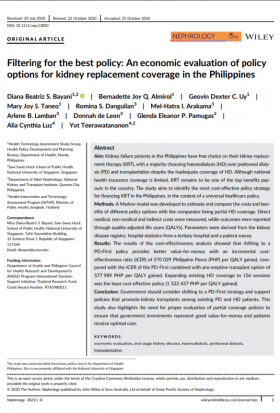This website uses cookies so that we can provide you with the best user experience possible. Cookie information is stored in your browser and performs functions such as recognising you when you return to our website and helping our team to understand which sections of the website you find most interesting and useful.
Filtering for the best policy: An economic evaluation of policy options for kidney replacement coverage in the Philippines

รายละเอียดเพิ่มเติม
Abstract
Aim
Kidney failure patients in the Philippines have free choice on their kidney replacement therapy (KRT), with a majority choosing haemodialysis (HD) over peritoneal dialysis (PD) and transplantation despite the inadequate coverage of HD. Although national health insurance coverage is limited, KRT remains to be one of the top benefits pay‐outs in the country. The study aims to identify the most cost‐effective policy strategy for financing KRT in the Philippines, in the context of a universal healthcare policy.
Methods
A Markov model was developed to estimate and compare the costs and benefits of different policy options with the comparator being partial HD coverage. Direct medical, non‐medical and indirect costs were measured, while outcomes were reported through quality‐adjusted life years (QALYs). Parameters were derived from the kidney disease registry, hospital statistics from a tertiary hospital and a patient survey.
Results
The results of the cost‐effectiveness analysis showed that shifting to a PD‐First policy provides better value‐for‐money with an incremental cost‐effectiveness ratio (ICER) of 570 029 Philippine Pesos (PHP) per QALY gained, compared with the ICER of the PD‐First combined with pre‐emptive transplant option of 577 989 PHP per QALY gained. Expanding existing HD coverage to 156 sessions was the least cost‐effective policy (1 522 437 PHP per QALY gained).
Conclusion
Government should consider shifting to a PD‐First strategy and support policies that promote kidney transplants among existing PD and HD patients. This study also highlights the need for proper evaluation of partial coverage policies to ensure that government investments represent good value‐for‐money and patients receive optimal care.
Click here to access the publication: https://onlinelibrary.wiley.com/doi/10.1111/nep.13830




